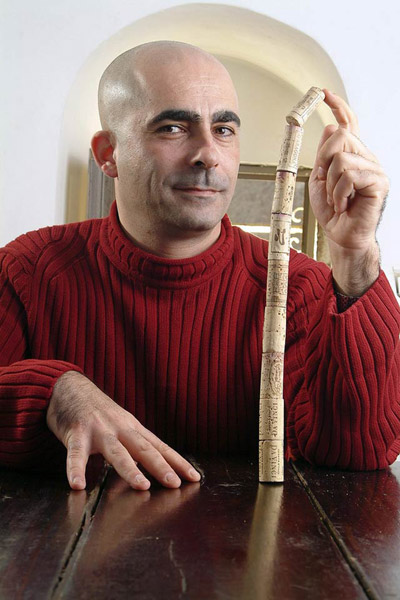By Desmond Bentley
The rise and rise of Israeli winemaking over the past 15 years has been well documented.
“We’re at the stage where we have sufficiently high-quality wines to penetrate world markets,” says Haim Gan, organizer of the
International Wine Exhibition in Israel, held this year on February 21-23, 2012, at the Israel Trade Fairs and Convention Center in Tel Aviv.
“This event represented the revolution in the Israeli wine industry,” says Gan, considered the country’s foremost wine expert. “We had about 18,000 visitors in three days. Dozens of exhibitors displayed their wares to representatives of wine importers from abroad, buyers and critics from all over the world. The industry needs this type of exposure.”
This year’s was the fourth wine expo, with the first day devoted to wine professionals such as buyers, barmen, exporters, importers, restaurateurs and critics, and the other two days open to the general public. It also saw the launch of several new lines.
“Israeli wines are of a higher quality than ever,” says Gan, who owns and operates one of the country’s best-known wine venues, the Grape Man House in the Old City of Jaffa.
“Some of our best young people are now studying how to become vintners abroad -- it’s become an alternative to law or medicine.”
Gradually, he says, a local style is emerging.
“Every country has its own wine. What we lack is demarcation -- to bring Israeli wines to a standard style. It will be interesting to see what type of wine emerges as quintessentially Israeli. The melting pot is slowly brewing. Part of the maturing of Israeli winemaking is that we now have some fine white wines, which are harder to produce than red wines.”
Meanwhile, favorable reviews are pouring in. Mark Squires of the prestigious Wine Advocate magazine wrote last year: “The corner has clearly been turned qualitatively. Israel has a real wine industry that deserves consumer attention. There are attractive wines with typicity and some distinction… Many are classic and charming and the best will impress anyone.”

Tastings at a previous International Wine Expo in Israel.
Photo by Ilan Levi
Reviving an old craft
Winemaking in this area can be traced back to remnants of a production site on the Spice Trail near Avdat built some 2,000 years ago. The first modern winery, the Carmel Winery in Zichron Yaakov, was founded by Edmond James de Rothschild in 1882.
But it wasn’t until the mid-1990s that Israelis began to realize that quality wines can be produced in a Middle Eastern climate, whether on the wind-swept hills of the Golan Heights or the low-lying lands of the Negev.
Now there are about 300 wineries in Israel, of which some 200 are small “boutique” operations. While many use state-of-the-art equipment and the type of knowledge only gained through studying, others are cottage-industry businesses.
The proliferation of wineries in recent years had even sparked a new branch of tourism focused on the various wine-producing areas -- including, naturally, tasting sessions.
The varieties produced in Israel include Cabernet Sauvignon, Merlot, Shiraz/Syrah, Cabernet Franc, Carignan, Petit Sirah, Argaman, Petit Verdot, Malbec, Pinot Noir, Sangiovese, Barbera, Zinfandel, Chardonnay, Sauvignon Blanc, Gewurztraminer, Viognier, White Riesling, Emerald Riesling, Chenin Blanc, Semillon, Muscat Canelli and Muscat of Alexandria.
Exports growing exponentially
Gan points to the emerging trends in local consumption. “We still drink far more red wines in Israel, although there is a tendency toward dry whites rather than semi-dry. Meanwhile the red wines are becoming lighter, less woody.”
Israelis consume less than eight liters per person every year on average, and the local market is tiny, notes Gan. About 70 percent of the wine consumed in Israel is red, 20% white, 7% sparkling and 3% rosé. About 15% of locally consumed wine is imported, mainly from Italy, Chile, Argentina, France and Spain.
Israeli wineries have to export to survive -- and have been doing so with increasing success. In 2001, exports totaled $8.01 million. By 2011 that figure had leapt to $26.7 million. More than 55% of exports find their way to the North American market, and more than 35% to Europe. The remainder goes to more than 30 countries in five continents. The leading importing countries are the US, France, Holland, the UK, Canada and Germany.
Eight wineries account for nearly 90% of Israel’s exports: Barkan, Binyamina, Carmel, Dalton, Galil Mountain, Golan Heights, Recanati and Teperberg.

Haim Gan of Jaffa’s The Grape Man House
“We have wines to send to anyone -- and not only kosher wines. Israel can meet the demand,” says Gan. “Israeli wines are selling in nearly 50 countries already, but they will always be relatively expensive. The costs here are high, for example manpower and water.”
He points out where the interest is coming from: “Korea, Japan, Taiwan, China, South America, Finland, Sweden, Norway -- countries that buy wines but don’t really produce much.”
The key to penetrating the world market lies in a country not noted for its winemaking, notes Gan: “Britain controls the market. The masters are all there, the leading critics, the top competitions. If you win the British you win the rest of the world.”
Video: Israeli Wine Revolution